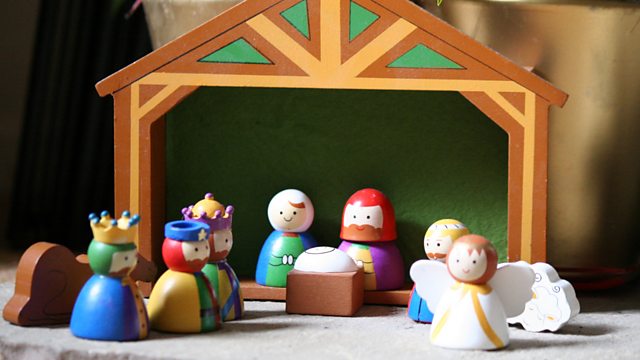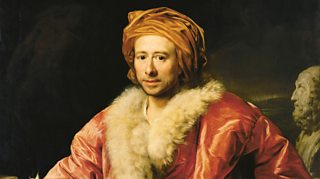Star of Wonder
Space scientist Monica Grady reflects on the symbolic power of the Star of Bethlehem.
"Science itself is like the Star of Bethlehem - leading Wise Men - and Wise Women - on journeys of investigation and discovery that, if we are fortunate, will echo down the years to inspire future generations to explore, to learn and to grow."
In a series exploring the enduring significance of the Nativity story, space scientist Monica Grady reflects on the symbolic power of the Star of Bethlehem.
Producer: Dan Tierney.
Last on
Script - Star of Wonder
In about 1305, Giotto di Bondone finished painting one of his most well-known works: the fresco in the Scrovegni Chapel in Padua. The fresco is a series of scenes, mainly from the life of the Virgin Mary, covering the walls of the church. One of the scenes is the adoration of the Magi, a very traditional depiction of three kings presenting their gifts of gold, frankincense and myrrh to the infant Christ. The baby is held in the arms of his mother, whilst Joseph the carpenter and an angel look on from either side of Mary, one of the Kings kneeling in front of the family. The stable in which Jesus was born is here shown as a rough shelter, a simple wooden roof supported by posts, and open to the elements. The stable is clearly away from other habitation – no ox or ass are there to provide additional warmth for the newborn child. Dominating the night sky, which occupies the upper third of the panel, is the star that the Magi, the Wise Men, followed to Bethlehem. The star is not a bright point of light, rather, it is a ball of light with an extended tail stretching out from behind. This perhaps rather forensic description of such a famous painting does not get across how moving the picture is for me. It draws you in to ask other questions of the imagery, particularly the way in which the Star of Bethlehem is interpreted by the artist.
It is widely believed that Giotto’s inspiration for this depiction of the star might have been the contemporary apparition of Halley’s comet in 1301. Giotto was not the first to record the appearance of Halley’s comet – about 230 years before Giotto lifted his paintbrush, Mathilda, the wife of William of Normandy, along with the ladies of her court, depicted a comet in embroidery. The Bayeux Tapestry is a record of the events leading up to the Battle of Hastings in October 1066 – and one of its panels includes a representation of a comet. Halley’s comet returns to the inner Solar System once every 76 years, and calculations indicate that it would have been visible in the night sky in the spring of 1066. The comet is named after Edmond Halley, the Astronomer Royal, who, in 1705, predicted that a comet seen in 1682, and on at least three separate occasions over the previous two hundred and fifty years was the same comet, and that it would return in 1758.
In this day and age, when our night skies are often tinged by the orange glow from street lights and darkness is kept at bay by the flick of a switch, it is difficult to picture how celestial events influenced people. OK, maybe we read our horoscope in the paper in the morning, but few of us take seriously the command to ‘make a break and explore pastures new’ or the promise that ‘romance is in the air’. But think what it was like 700 years ago, when Giotto was painting his frescos, or two thousand and sixteen years ago, when Christians date the birth of Jesus. The night sky was completely lit by the brightness of stars. Because the turn of the seasons and the agricultural year were marked by changes in what appeared in the heavens, any untoward event, such as a bright comet, caused consternation and excitement. So it is quite likely that Giotto saw Halley’s comet and thought it was an appropriate image to record in his depiction of the Adoration of the Magi. Similarly with the ladies of eleventh century England and France. The Bayeux Tapestry records the death of King Harold of England – and the fortuitous appearance of a fiery-tailed comet in the night sky would have been a suitable omen of King Harold’s fate.
The most recent closest approach of Halley’s comet to the Sun was 1985 to 1986. The European Space Agency – abbreviated to ESA - took advantage of the occasion to launch the first space mission to a comet – and in recognition of the importance of his contribution to recording the appearance of a comet, ESA named the mission Giotto. The Giotto spacecraft flew about 600 km from Halley’s comet, and took the first close-up picture of a comet nucleus. The mission was a great success, and achieved its goals, but scientists knew, even before the spacecraft encountered Halley’s comet, that instruments on-board Giotto would not collect all the information required to understand the origin of this icy traveller. Another cometary mission would be required – the Rosetta mission to comet 67P/Churyumov-Gerasimenko. The main part of the Rosetta mission took part between October 2014 and 2015, before finally ending in September this year. I was really privileged to have a very small role in Rosetta – a role which gave me one of the most exciting and thrilling moments of my scientific career.
I’m fascinated by comets because when you see one with the naked eye, their appearance really does arouse emotions that cannot be too different from those experienced by peoples of earlier times. Comets are small bodies, up to a few tens of kilometres across. They were thought to be mainly ice, with some dust – a dirty snowball, as the astronomer Fred Whipple famously described them in the 1950s. But Giotto’s encounter with Halley’s comet showed that they were much more like icy dirtballs – and after Rosetta flew past Churyumov-Gerasimenko, that description changed to gravelly mudball.
Why are comets so important, that some scientists spend their career studying them? Back about four thousand five hundred and sixty seven million years, when the Sun was born from a swirling cloud of gas and dust. Most of the gas went into building the Sun – but there was enough still remaining to form the giant planets, whilst the dust grains clumped together to produce rocky planets and asteroids. Comets were built from the accumulation of ice-covered dust grains, in a region of the Solar System far enough away from the Sun that they have not been altered by its heat. They are also rich in compounds that contain carbon – organic molecules that may be distant precursors of the DNA that builds our genes. This is why comets are important: the dust and ice, plus any trapped gas, that make up comets, are unchanged survivors from the very earliest part of Solar System history - the material that eventually helped to make Earth habitable and enabled life to arise.
The Rosetta mission was twenty years in the planning, followed by ten years of travel from launch until the spacecraft reached its target. The most ambitious part of the mission was to land a small craft, Philae, about the size of a domestic washing machine, on the surface of the comet. Scientists and engineers associated with the project, plus politicians and journalists, were invited to ESA’s Space Operations Centre in Darmstadt, Germany, to witness the event, which took place on the twelfth of November 2014. I was also fortunate to receive an invitation, in my capacity as a member of the science advisory team to the Ptolemy instrument, a miniature gas analyser, designed and built at the Open University.
Because the comet was so far from Earth – about 500 million kilometres – signals took twenty minutes to travel between Earth and the spacecraft, so the landing manoeuvre had to be pre-programmed. Philae was released from Rosetta at ten o’clock in the morning, and took seven hours to the surface of comet 67P. The event was a curious mix of hanging around waiting for something to happen together with short bursts of frantic excitement when an image or piece of information was released. By half past four in the afternoon, the atmosphere at ESOC was intense – thirty years of waiting would shortly end – but in success or failure? When the landing signal was received, there was joy and happiness – and I received my ‘fifteen minutes of fame’ when my enthusiastic reaction to the landing went viral over social media.
This was the storm before the calm. It was not long after the excitement that we heard the landing hadn’t gone quite as planned. The harpoons designed to anchor the craft had not fired, meaning Philae had bounced before arriving a few hundred metres away from its designated landing site. Philae was not moored in the middle of a flat and sunlit plain, but was wedged, on its side, in a dark crevasse. Philae was operational – for 70 hours – using up the power from its main battery. But the secondary, solar-powered batteries could not charge, so Philae’s activities ceased when the main battery died. Even so, instruments on the lander achieved almost all their science goals, and we know a lot more about the interior and exterior of comet 67P than we ever dreamed we could know.
So let’s go back to the Christmas story.
We still have no idea whether the Star of Bethlehem was a comet. Over the years, historians, theologians and astronomers have advanced different explanations for the phenomenon that apparently led three Wise Men out of the east to the small and indistinguished town of Bethlehem. It might have been comet, as depicted by Giotto. It might have been a planetary conjunction – a time when two or more planets appear very close together in the sky. Then again, it might have been a supernova –an ancient star exploding in a blaze of glory, the brilliant flames of its dying moments lasting for several months before fading away.
Does it matter that there is no consensus by astronomers over interpretation of the Star of Bethlehem? I don’t think so. In my opinion, once consensus is reached, then debate and research – and interest – often fade away, as attention focuses on problems that remain to be solved. Coming back again to Rosetta – have we gathered sufficient information to close any debate about comets and the origin of life? Can we draw a line under cometary research, and say that results from Rosetta and Philae answered every unknown that we had about our icy travellers? I am very pleased to say that we have nowhere near enough information. The close-up images of the craggy and gravel-strewn landscape of comet Churyumov-Gerasimenko have caused us to question how comets age and evolve. Results from the instruments have told us that yes, water and some of the organic chemicals required for life are present in comets. But they have also told us that other chemicals are present that should not be there if our understanding of the physics of how the Solar System was put together is correct. And that is excellent news. This is how science progresses, in slow stages, followed by a sudden great advance, opening up more questions.
The Star of Wonder may not have been a comet, but comets have certainly left us wondering.
As a scientist I’m, of course, fascinated by what the Star might be, which goes back to when, as I child, I wondered why it played such a prominent role in the Christmas story. As a Christian and as an adult, I now see the Star of Bethlehem as a part of the poetry that surrounds my faith. I see it as imagery that enriches the stories that are told to help understand and appreciate the more mysterious aspects of a religion that requires birth from a virgin and resurrection from the dead. If you are not a believer, then it doesn’t matter one way or the other – it is just another story.
If the Star of Bethlehem were a comet there are beautiful parallels that can be drawn between it and the Rosetta mission. For instance, the length of the journey that three Wise Men took following the star is like the convoluted path that Rosetta followed for ten years as it built up sufficient momentum to catch its comet.
Science itself is like the Star of Bethlehem – leading Wise Men – and Wise Women – on journeys of investigation and discovery that, if we are fortunate, will echo down the years to inspire future generations to explore, to learn and to grow.
The excitement when we saw the first pictures of the surface of 67P was indescribable. I like to think of the Magi as punching the air and high-fiving as they see the infant Jesus, shouting their joy ‘We’ve found Him’.
That’s what Christmas means to me.
Broadcast
- Tue 20 Dec 2016 22:4591�ȱ� Radio 3
Death in Trieste
Watch: My Deaf World
The Book that Changed Me
Five figures from the arts and science introduce books that changed their lives and work.
Podcast
-
![]()
The Essay
Essays from leading writers on arts, history, philosophy, science, religion and beyond.





